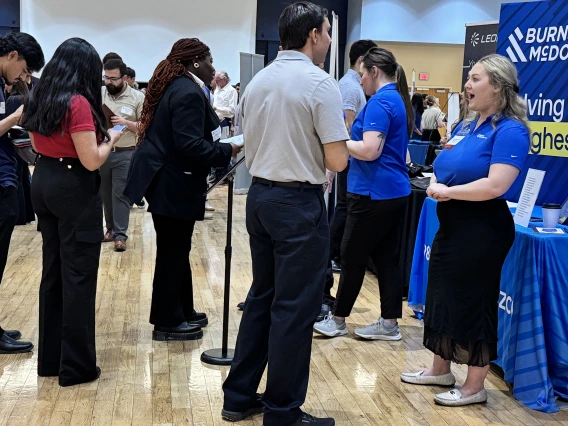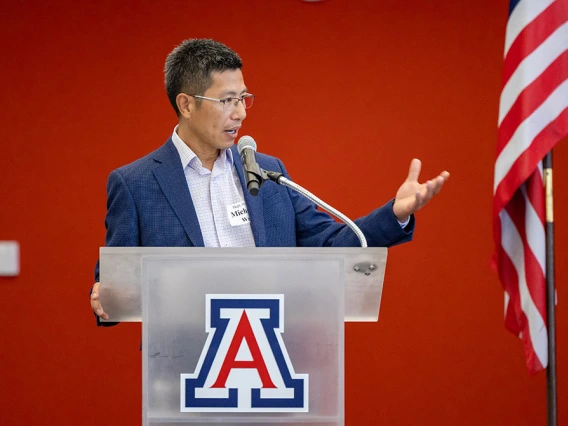ECE team wins first place in the inaugural AI-Hardware Design League
AI-HDL brings together students from different backgrounds and five nations to learn about hardware design, artificial intelligence in chip development.
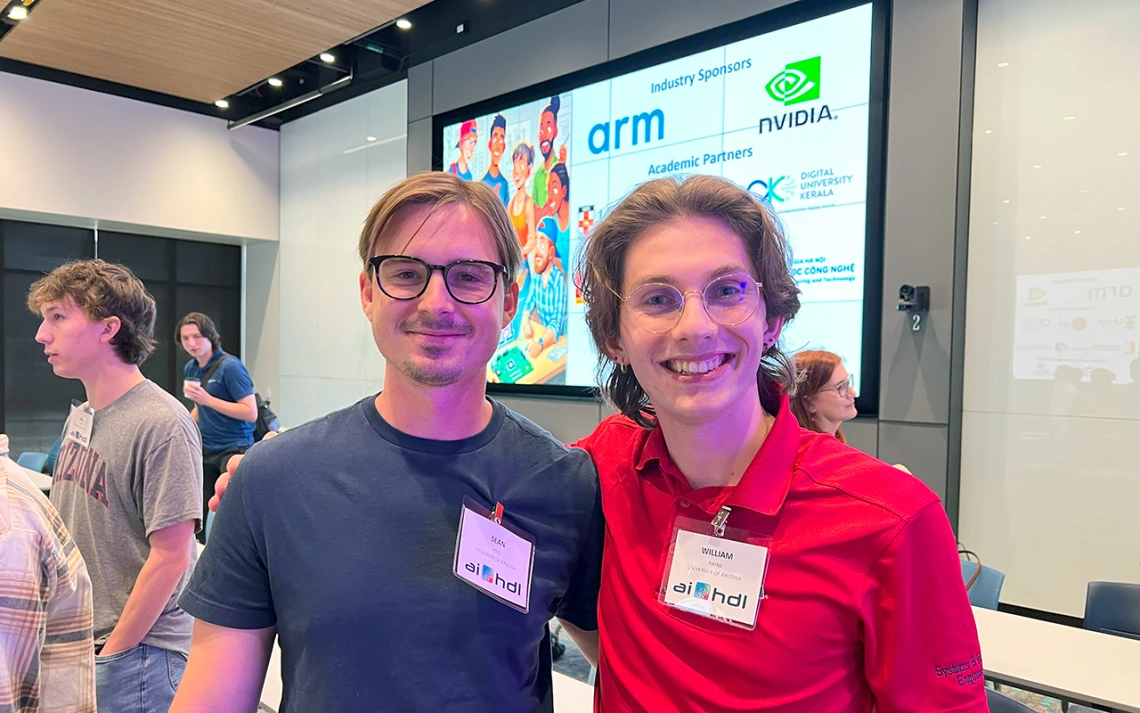
Electrical and computer engineering student Sean Rice (left) says his mentor William Rains was an excellent source of support during the competition. Rains, an undergraduate software engineering student, is part of a volunteer group of U of A students acting as mentors to the AI-HDL teams, providing AI training and online office hours.
College students around the world in the Artificial Intelligence Hardware Design League (AI-HDL) have been designing secure semiconductor chips for smartwatches since October 2024. The inaugural competition wrapped up March 27 with the best overall design winner, the University of Arizona team AI or Die, walking away with $5,000 and lasting industry connections.
“Everyone in the Center for Semiconductor Manufacturing is thrilled to see the first student finalists in the AI-HDL finish up their designs, and we’re impressed with what they have accomplished,” said Krishna Muralidharan, incoming director for the U of A center and professor in the Department of Materials Science and Engineering.
The University of Arizona’s Department of Electrical and Computer Engineering organized the competition, which brought together students from community colleges, academic institutions worldwide, and industry leaders. Sponsors included the Center for Semiconductor Manufacturing, Institute for Computation & Data-Enabled Insight (ICDI), ECE, and chip design companies Arm and Nvidia.
“With the institute’s focus on growing Arizona’s economy and the development of novel computing technologies, the AI-HDL initiative aligns with our mission,” said Barney Maccabe, executive director of ICDI and professor in the College of Information Science.
“An introduction to skills and experience in the growing semiconductor industry are part of Arizona’s future.”
Integrating AI spurs ideas
The March 27 event celebrated the accomplishments of undergraduate and graduate competitors with a combined program featuring an awards ceremony and a semiconductor career panel.
AI or Die leader Sean Rice attributed the win to strong teamwork and AI tools such as generative pre-trained transformers, or GPTs. These large language models are used in widely accessible AI tools such as ChatGPT.
“It provides an extremely rich source of information really quickly,” the ECE junior told KGUN9 News. “You ask the AI ‘why might this not be working,’ and it’ll provide a suggestion.”
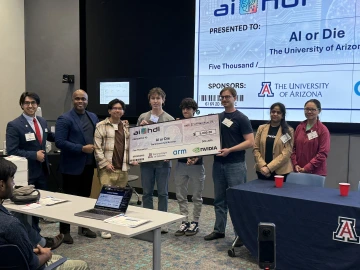
Winning team AI or Die accept a $5,000 check from Nvidia.
The help paid off for Rice and fellow ECE juniors Jerald Ocaya, Jacob Grudinschi and Sam Lovas. Not only did AI or Die win best overall design among the 11 teams that finished the competition, but also the team placed first in the undergraduate student category.
Teams ranged from three to five members and were evaluated on design security, energy usage, and area efficiency, and ranked within two academic levels: community college and undergraduate students, and graduate students.
Rice, who is researching quantum optics with associate professor of ECE and optical sciences Boulat Bash, said the competition has opened doors to unexpected career paths.
“AI is super interesting, and semiconductor manufacturing is also surprisingly fascinating,” he said. “I'm kind of at a fork in the road, and doing well in this competition is piquing my interest in exploring this domain further.”
Lowering the barrier to high-paying jobs
Soheil Salehi, founder of AI-HDL and assistant professor of ECE, said workforce development is key given that Arizona is attracting chip manufacturers such as Intel and the Taiwan Semiconductor Manufacturing Company.
“There are so many job opportunities, but few candidates who would pursue those positions.”
Including students from community colleges and international universities, many of whom who had no background in semiconductors, helped raise awareness about career opportunities.
“The goal is to bring in students who think entry into this area has a high barrier and show them it doesn’t,” said Salehi, who has a joint appointment in the Department of Systems and Industrial Engineering.
In addition to the University of Arizona, students from Pima Community College and Pasadena City College competed. The competition’s virtual component broadened access for international teams, including students from the University of New South Wales Sydney in Australia, Hanoi University of Science and Technology and VNU University of Engineering and Technology in Vietnam, Digital University Kerala in India and Heidelberg University in Germany. Out of the 172 participants, roughly 72% started with no experience in hardware design and nearly 47% had no prior experience using generative AI tools.
“We are developing the next generation of talent in semiconductor design,” said Salehi, who plans to grow the competition over the next two years, including adding high school students to the mix.
Powerful partners
Partners and sponsors for AI-HDL are all in.
“We are huge supporters. We want to see this grow every year,” said Stephen Ozoigbo, head of government partnerships and ecosystems at Arm.
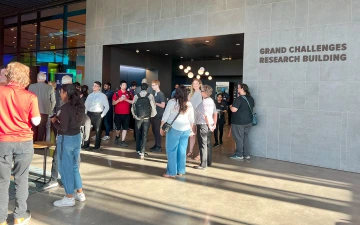
AI-HDL teams mingle with industry leaders in the U of A Grand Challenges Research Building.
“The current state of the industry is highly favored to self-directed learners,” he told students during the semiconductor career panel, “so get comfortable with the stuff that makes you uncomfortable and participate in forums like this.”
Also on the panel were ECE professor Janet Roveda and Vidya Murali, senior director of AI computer toolkit at Nvidia. The panelists offered valuable insights into the semiconductor job market, highlighting the growing demand for engineers from diverse disciplines.
“Everyone can write code,” Murali said. “Anyone from any department can be involved, and it’s so democratized now.”
AI-HDL winning teams
Best overall design – Team AI or Die (U of A)
Most secure design – UET2 (VNU University of Engineering and Technology)
Most energy-efficient design – DigiDynamos (Hanoi University of Science and Technology)
Most area efficient design – CC-1 (Pima Community College)
Community college and undergraduate division
1st place: AI or Die (U of A)
2nd place: UET2 (VNU University of Engineering and Technology) tied withDigiDynamos (Hanoi University of Science and Technology)
3rd place: CC-1 (Pima Community College)
Graduate division
1st place: UHD CAT (University of Heidelberg)
2nd place: UET1 (VNU University of Engineering and Technology)
3rd place: UET3 (VNU University of Engineering and Technology)
4th place: ChipX (The University of Arizona)


